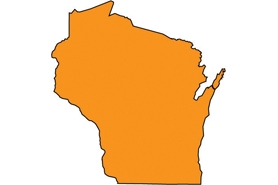Brown knapweed
(Centaurea jacea)
Perennial knapweed with upright stems, that branch near the top. Flowers are lavender-colored with fringed bracts that have brown tips.
Other names for this plant include:
- Common names: Brownray knapweed
Classification in Wisconsin: Restricted
- Ecological Threat
-
- Invades open grasslands, prairies, open forests, orchards, cultivated fields, field edges and travel corridors.
- Aggressively outcompetes desired vegetation, reducing overall biodiversity and forage quality.
- Plants are easily spread by human activity via seed and the plants' characteristics facilitate increased seed dispersal across long distances.
- Plants produce up to 800 seeds per plant. Upon maturation, seeds eject and can be dispersed as far as 20 feet from the parent plant.
- Increases soil erosion and consumes soil nutrients.
- Identification
-
Leaves & stems: A single upright stem branch near the top. Leaves are lanceolate and undivided. Leaf size progressively decreases from bottom to top. Stems are ridged, sometimes with purple-colored striations.
Flowers: Flowers are rose from lavender to purple in color. Bracts (long fringes beneath the flowerhead) tips are brown in color and wider than at the base. They have papery thin margins with a dark brown center.
Fruits & seeds: Seeds are tan in color with fine hairs. There is no pappus. Plants produce on average a few thousand seeds per plant.
Roots: Plants have woody taproots and a woody root crown.
Similar species: Brown knapweed closely resembles other knapweeds, the majority of which are also invasive in Wisconsin.
- Control
- Mechanical:
- Handpull the plants, being sure to remove the entire taproot.
- Mow or cut plants before flowering to prevent seed set. Note this will not kill the plants.
- Herbicide treatments are most effective when combined with other control techniques and followed by re-seeding. The timing of herbicide treatments is essential to effectiveness.
- A 3% solution of triclopyr herbicide mixed with water can be applied to the leaves in early spring or fall.
- Glyphosate, picloram, 2,4-D and clopyralid have all been used on other knapweeds.
- Gall flies (Urophora affinis and Urophora quadrifasciata) are used to feed on the developing seed heads.
- Resources
- Sources for content:
- Washington State Noxious Weed Control Board
- USDA Forest Service



